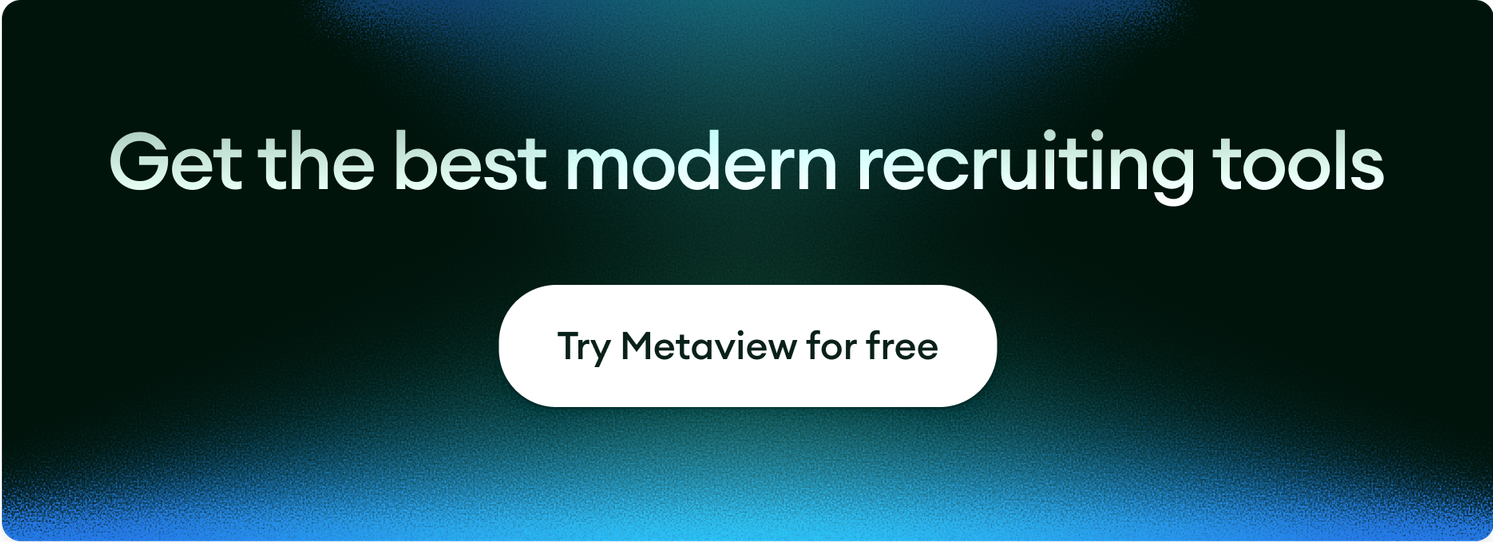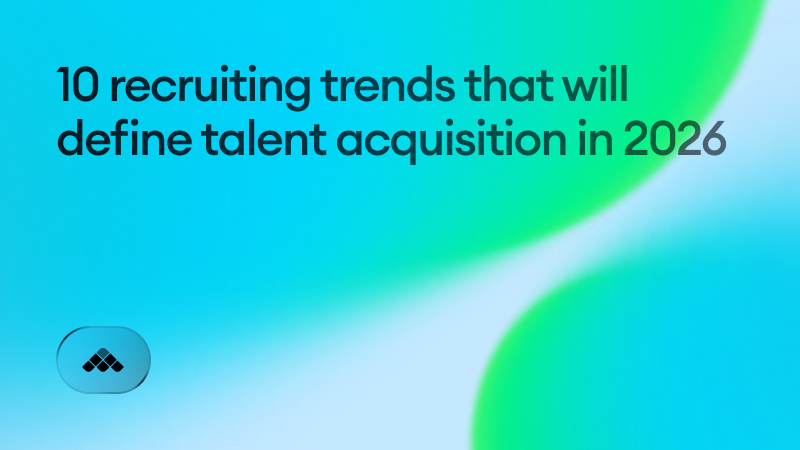Recruiting is entering a new era defined by automation, analytics, and precision. Talent teams are expected to do more with less, hire fast and with precision, while maintaining a premium employer brand and candidate experience.
The next year will challenge recruiting leaders to balance efficiency with empathy, and technology with human judgment. The hiring process is becoming leaner, more data-driven, and far more integrated than ever before.
In this guide, we’ll explore the key recruiting trends shaping 2026, from AI-powered sourcing and predictive analytics, to community-driven recruiting and personalized candidate experiences. These aren’t just passing fads—they’re the forces redefining how companies identify, attract, and secure top talent.
3 key takeaways
- Recruiting in 2026 will be defined by automation and insight, not intuition. Data is now every recruiter’s most valuable asset.
- Precision sourcing and personalization will replace high-volume pipelines and generic outreach.
- Recruiters who embrace technology and storytelling will thrive as strategic advisors, not just process managers.
10 key recruiting trends for 2026
The recruiting landscape is always shaped by economic shifts, emerging technologies, and changing candidate expectations. These ten trends highlight where forward-thinking organizations are focusing their efforts to stay ahead.
1. Fewer candidates; smarter targeting
Modern candidate sourcing is shifting away from a pure quantity play. Instead of sourcing hundreds of candidates per role, talent teams will focus on finding smaller pools of exceptionally well-matched prospects.
Which makes perfect sense: you don’t actually want an endless hiring pool of largely anonymous candidates. That’s just LinkedIn.
AI and advanced filtering make it easier to identify candidates who not only have the required skills, but also the right behaviors and cultural fit for your organization. You deliver a handful of ideal fits for each role, and hiring managers are thrilled to dive into interviews.
This shift helps recruiters reduce time to hire, eliminate wasted outreach, and ensure that hiring decisions are based on real potential rather than guesswork.
What it means for recruiters: Focus on smaller, more relevant pipelines with higher response rates, improved offer acceptance, and stronger hiring manager satisfaction.
2. Fully automated talent sourcing
Manual sourcing is on its way out. We already have AI sourcing agents operating continuously to analyze job descriptions, team performance data, and market trends. You can fill your hiring pipeline literally in your sleep.
These systems review thousands of profiles across LinkedIn, GitHub, and niche platforms, surfacing the best matches in seconds. Recruiters simply refine or approve the AI’s recommendations, rather than starting searches from scratch.
What it means for recruiters: Automated sourcing means recruiters can spend more time engaging with and closing better candidates. More time for the high-value human work that drives better results.
3. A community-oriented recruiting approach
As competition for talent intensifies, companies need better candidate outreach and engagement strategies. Leaders in the space are already building sustainable talent communities instead of one-off sourcing lists.
A talent community includes past applicants, referrals, alumni, and passive candidates who’ve interacted with your brand. Recruiters nurture these groups through email campaigns, events, and career resources, keeping them engaged even when roles aren’t open.
What it means for recruiters: Global retailers and tech firms are already using talent CRMs to manage pre-qualified pipelines. When new openings arise, these “warm” communities can cut time to fill by 40–60%.
4. Interview intelligence as a core recruiting function
Interviews are one of the most valuable sources of recruiting data. And in 2026, more recruiters will realize and capitalize on this simple fact.
Use AI-driven interview intelligence to capture and analyze every conversation. Get near-instant insights about candidate quality, interviewer performance, and hiring consistency.
Tangibly, this technology helps teams spot patterns, like which questions lead to stronger hires, or where bias may influence decisions. Recruiters can then coach interviewers and improve every stage of the process.
What it means for recruiters: Interviews hold enormous untapped value. With AI capturing and structuring that information, teams can make faster, fairer, and more data-backed hiring decisions.
5. Skills-first hiring over resumes
Traditional hiring based on resumes and credentials is fading fast. Instead, skills-first hiring lets you better assess candidates based on their competencies, adaptability, and potential.
AI-powered assessments, portfolio-based screening, and performance data help teams look beyond degrees or job titles to uncover candidates who can truly deliver. This approach also promotes diversity, removing barriers for those with nontraditional backgrounds.
What it means for recruiters: Job descriptions must evolve from rigid requirements to flexible skill clusters, opening access to broader, more inclusive talent pools.
6. AI-powered personalization in candidate experience
Imagine receiving a job recommendation based on your past roles, interests, and preferred work style, followed by interview feedback that feels genuinely individual and tailored. That’s where the industry is heading.
Personalization is arguably the hallmark of exceptional recruiting. That will always require human intuition and experience, but modern technology is making it more scalable.
AI tools customize outreach messages, interview feedback, and offer communication to match each candidate’s motivations and career goals.
What it means for recruiters: Personalization drives engagement and offer acceptance. It’s a non-negotiable, so choose tools to help you overcome any logistical hurdles. Candidates who feel seen and understood are far more likely to choose your company over others.
7. Recruiters as strategic advisors
As automation handles repetitive sourcing, scheduling, and reporting tasks, recruiters will evolve into strategic talent advisors. They’ll partner with executives to forecast hiring needs, assess skills gaps, and guide workforce planning based on real-time data.
This is a positive for the profession. Your influence will move beyond filling roles to shaping the organization’s future capabilities.
As recruiters take more strategic seats at the table, they’ll be better resourced, higher compensated, and indispensable to the future of the organization.
What it means for recruiters: Recruiters who can translate hiring data into business strategy will become irreplaceable partners to leadership.
8. Data-driven diversity and inclusion
DE&I may not get the same level of focus as it did in recent years. But it’s still an essential HR concern, so we need ways to ensure diversity without the resources we once enjoyed.
AI and analytics tools make it easier to track representation across sourcing channels, candidate pipelines, and interview panels. Talent teams have the visibility and data needed to achieve diversity more easily.
Beyond measurement, tools will help identify bias in interviews, job descriptions, and outreach messaging. You’ll get fairer hiring, broader reach, and stronger organizational equity.
What it means for recruiters: Diversity isn’t a compliance checkbox. Nor is it a headwind against fast growth. It’s a competitive advantage tied directly to innovation, performance, and retention.
9. End-to-end recruiting automation
Recruiting workflows will finally become fully automated and integrated. From sourcing and scheduling to feedback collection and offer creation, automation will eliminate time sinks and improve speed across the funnel.
Integrating ATS systems like Greenhouse, Ashby, and Lever ensures every candidate interaction is tracked, summarized, and optimized in one place. And connecting those to business intelligence and broader HR tools makes your entire hiring process more robust.
What it means for recruiters: Talent teams will hire faster and with fewer errors, reducing costs while improving candidate and hiring manager satisfaction. But you need to prioritize deep integrations and automation to get there.
10. Predictive analytics and workforce planning
Predictive analytics will be the new gold standard for strategic recruiting. Using data on hiring velocity, performance outcomes, and attrition trends, TA leaders will forecast hiring needs before they become urgent.
For example, predictive dashboards might show that a certain role or department is likely to see turnover within six months. Recruiters can start sourcing and building their pipelines right away.
What it means for recruiters: Instead of reacting to vacancies, teams will plan their pipelines ahead, ensuring hiring aligns seamlessly with business growth.
How Metaview is leading the way
Metaview is a key ally to meet the recruiting trends above. It helps modern talent teams work smarter, faster, and with greater clarity.
Here’s how Metaview enables the future of recruiting:
- AI interview intelligence: Automatically records, transcribes, and summarizes interviews, giving teams structured insights to improve hiring decisions.
- Automated sourcing: AI agents fill your pipeline automatically, analyzing job descriptions and finding ideal candidates based on your data.
- Recruiting analytics: Dashboards visualize team performance, time to hire, and candidate conversion rates.
- Interviewer enablement: Provides feedback and coaching tools to improve interview quality and consistency.
By turning every conversation into usable data, Metaview helps recruiting teams move beyond intuition and into a future of continuous improvement, powered by AI.

Build the perfect talent acquisition strategy for 2026
The recruiting landscape in 2026 will reward teams that embrace change. AI will handle more of the heavy lifting, while recruiters focus on strategy, empathy, and building relationships that matter.
Data will drive every decision, automation will eliminate friction, and personalization will define great candidate experiences.
The future belongs to those who adapt now, blending technology with human intelligence to hire better, faster, and fairer.
Ready to build your 2026 recruiting strategy? Try Metaview for free and see how AI interview intelligence and automation can transform the way you hire.
Recruiting trends FAQs
1. What is the biggest recruiting trend for 2026?
The most significant trend in 2026 will be the rise of end-to-end recruiting automation, powered by AI. Recruiters will rely on automation to source candidates, schedule interviews, and summarize conversations, while focusing their time on strategic work like building relationships and advising hiring managers.
This shift means recruiting teams can remain lean, while still scaling hiring processes with more data than in the past.
2. How will AI change talent acquisition in 2026?
AI is the backbone of the recruiting process. Instead of manually searching for candidates or writing outreach messages, AI sourcing agents handle the heavy lifting, continuously scanning databases and networks to surface qualified matches.
Meanwhile, AI interview intelligence tools like Metaview will analyze interviews, helping teams improve interviewer performance, reduce bias, and make faster, evidence-based decisions. The result is smarter, more consistent hiring across the board.
3. Will recruiters be replaced by AI?
No, AI won’t replace recruiters. But it will take over routine tasks like data entry, scheduling, and resume screening. Recruiters will evolve into strategic advisors who interpret insights, strengthen employer branding, and build meaningful relationships with candidates.
In other words, AI will remove busywork so recruiters can focus on what humans do best.
4. How can smaller recruiting teams prepare for these 2026 trends?
Smaller teams can start by automating one or two processes, such as interview transcription or sourcing automation. They should also prioritize data hygiene: ensuring candidate and performance data is centralized, accurate, and easy to analyze. These steps will make it easier to scale as AI tools mature.
Platforms like Metaview help lean recruiting teams that want enterprise-grade intelligence without complexity.
5. What’s the role of data in modern recruiting?
Data is the foundation of every modern recruiting decision. It helps teams track sourcing performance, identify pipeline bottlenecks, measure interviewer effectiveness, and forecast hiring needs.
In 2026, predictive analytics will go further, helping recruiters anticipate which roles need hiring soon or which candidates are most likely to succeed.
6. How will candidate experience evolve in 2026?
Candidate experience will become hyper-personalized. AI will tailor communications, interview feedback, and even offer details to match individual motivations and career goals.
Recruiters will use automation to maintain constant engagement — without losing the personal touch. This balance between empathy and efficiency will define the world’s best hiring experiences.
7. Why are talent communities trending?
Talent communities are groups of pre-engaged candidates who have shown interest in your company but aren’t yet applying for roles. They’ve become critical in competitive markets, allowing recruiters to build long-term relationships and hire faster when roles open.
AI tools will make it easier to nurture and segment these communities, sending tailored updates and relevant opportunities automatically.
8. How can recruiters stay competitive in 2026 and beyond?
Recruiters can stay competitive by developing a hybrid skill set, combining technical fluency with human connection. That means becoming comfortable with AI tools and analytics dashboards, while also improving storytelling, negotiation, and relationship management.
The best recruiters in 2026 will understand both the data and the people behind it.


